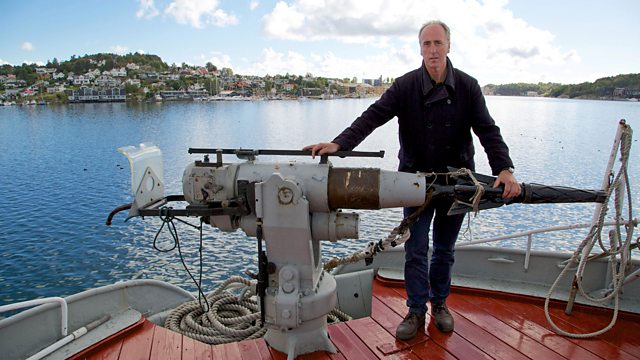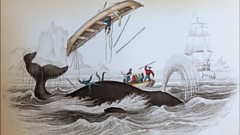
The Rise
Archive footage and testimony from the last of the whale hunters helps Adam Nicolson reveal what it was like to have hunted whales in Antarctica in the early 20th century.
Writer Adam Nicolson is granted rare access to the ruins of the whaling stations on the remote British island of South Georgia. Amazing rarely seen archive footage and first-hand testimony from the last of Britain's whale hunters reveals what it was really like to have been a whale hunter in Antarctica, providing Europe with essential oils for soap and food. Putting our modern environmental guilt to one side, this provocative series looks at how and why whale populations were so drastically reduced in the 20th century and attempts to see whaling through the eyes of the time.
A few hundred years ago the oceans were home to millions of whales, but then we found that they were incredibly useful for everything from lighting and fashion to soap and food. Adam discovers the remarkable, forgotten tale of Britain as a major whaling nation right up to the 1960s, while exploring the incredible ruins of its largest centre on the remote British island of South Georgia.
Adam starts his journey on the west coast of Scotland, his favourite place to escape to since boyhood. It's his realisation that these waters would have once been home to many whales that has prompted him to find out about whaling. He sails up the coast to Stornoway harbour, where there's a vivid account of a traditional hunt of pilot whales.
He discovers how whaling was commercialised to supply Britain's growing cities with a vast range of products: from corsetry and umbrella stays to street lighting. But the real shift in the scale of the industry comes in the late 19th century with the inventions of Norwegian Svend Foyn. Adam joins the British whalers on a restored whale-catching ship in Norway, where they explain how grenade-tipped harpoons and steam winches revolutionised the type and number of whales that could be hunted.
With whale populations in the north becoming hunted out by the start of the 20th century, the whalers turned their attention to the Antarctic. Adam travels via the Falkland Islands to the remote and spectacular Antarctic island of South Georgia. This uninhabited British outpost very quickly became the centre of the world's whaling industry, with six whaling stations. The biggest, Leith Harbour, belonged to the world's largest whaling company at the time - Christian Salvesen from Edinburgh.
Adam explores this complete whaling town, a time capsule of Brtiain's industrial past, which was abandoned in 1965. He finds huge, asbestos-clad machinery and pieces together how whales were processed, and after hearing about the whalers' illegal hooch, discovers a hidden still in one of the bunkrooms.
The episode ends with the peak of whaling on South Georgia in the mid-1920s - over 8,000 whales were killed and processed in a year. New processes meant that whale oil could now be used to make much-needed soap and edible fats for Europe, and Salvesens were making an annual profit equivalent to 拢100 million in today's economy. But, thanks to a revolution in ship design, the whaling industry was about to become far bigger still.
Last on
More episodes
Previous
You are at the first episode
Next
See all episodes from Britain's Whale Hunters: The Untold Story
Clips
-
![]()
Whale products and whaling in the 18th and 19th century
Duration: 02:35
-
![]()
Arrival at South Georgia
Duration: 02:12
-
![]()
Leith Harbour Whaling Station
Duration: 01:42
Credits
| Role | Contributor |
|---|---|
| Presenter | Adam Nicolson |
| Producer | Tom Beard |
| Director | Tom Beard |
| Executive Producer | Andrew Palmer |
| Executive Producer | Will Anderson |
A glimpse into the world of British whaling in the 1950s
A unique look at life working in the whaling industry in Antartica



